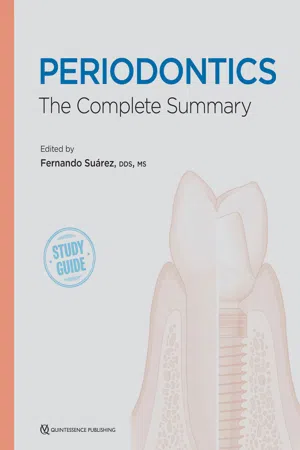
- 368 pages
- English
- ePUB (mobile friendly)
- Available on iOS & Android
About this book
This expansive textbook covers a broad range of topics to prepare aspiring periodontists for exams as well as serving as a guide or reference for more senior practitioners. Concepts are explained in language simple enough for students but technical enough to communicate the important points and subtleties of the topic. Over 100 vocabulary words are clearly defined and explained in context to facilitate understanding of the material, and the text is accompanied by a great variety of tables, diagrams, and illustrations to allow readers to visualize the area and provide additional context for the information. The textbook begins with a basic overview of periodontal anatomy, then leads the reader through the process of diagnosis, identifying different diseases and potential risks before obtaining a prognosis and creating a treatment plan. This is followed by over a dozen chapters on various treatment methods from SRP to complex surgery and then maintenance. The book concludes with additional concepts important for young dentists to know, including an overview of relevant medications as well as abnormalities and emergencies that may be encountered in daily practice. Nothing is left out in this handy study guide, and both current students and recent graduates will find it invaluable in beginning their careers.
Frequently asked questions
- Essential is ideal for learners and professionals who enjoy exploring a wide range of subjects. Access the Essential Library with 800,000+ trusted titles and best-sellers across business, personal growth, and the humanities. Includes unlimited reading time and Standard Read Aloud voice.
- Complete: Perfect for advanced learners and researchers needing full, unrestricted access. Unlock 1.4M+ books across hundreds of subjects, including academic and specialized titles. The Complete Plan also includes advanced features like Premium Read Aloud and Research Assistant.
Please note we cannot support devices running on iOS 13 and Android 7 or earlier. Learn more about using the app.
Information
1
ANATOMY
Miguel Romero Bustillos, DDS, PhD
DEFINITIONS AND TERMINOLOGY
Periodontium: Attachment Apparatus
PERIODONTAL LIGAMENT
Origin

Composition
Table of contents
- Cover
- Halftitle Page
- Copyright Page
- Title Page
- Contents
- Foreword
- Preface
- Contributors
- 1 Anatomy
- 2 Examination and Diagnosis
- 3 Gingivitis and Periodontitis
- 4 Risks
- 5 Local Anatomical and Contributing Factors
- 6 Occlusal Trauma
- 7 Prognosis
- 8 Treatment Planning
- 9 Nonsurgical Therapy
- 10 Surgical Nonregenerative Therapy
- 11 Surgical Regenerative Therapy
- 12 Tissue Engineering
- 13 Periodontal Chemotherapeutics
- 14 Periodontal Wound Healing
- 15 Alveolar Ridge Preservation
- 16 Dental Implants
- 17 Marginal Bone Loss
- 18 Peri-Implant Diseases
- 19 Horizontal Bone Augmentation
- 20 Vertical Bone Augmentation
- 21 Sinus Augmentation
- 22 Mucogingival Therapy
- 23 Periodontal and Peri-Implant Maintenance
- 24 Interdisciplinary Treatment
- 25 Evidence-Based Dentistry
- 26 Oral Medicine and Pathology
- 27 Pharmacology
- 28 Medical Emergencies
- Index